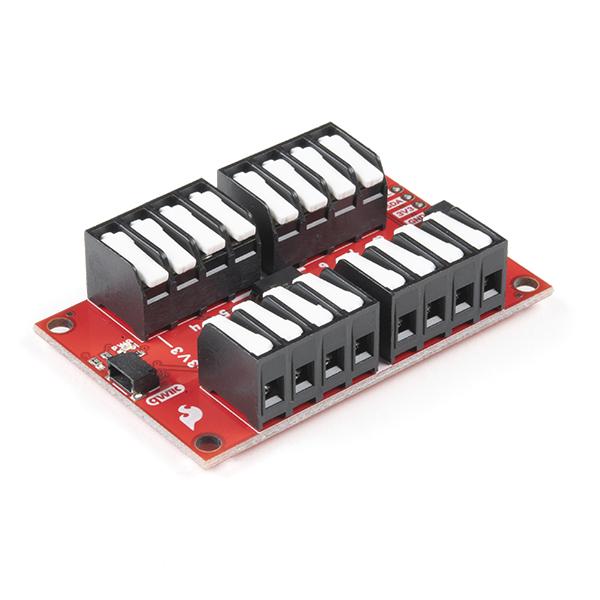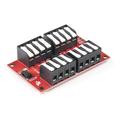SparkFun Qwiic GPIO

Description Links Attachments
Sparkfun Qwiic GPIO's use of I²C interface simplifies the process, as all the technical details are taken care of in an Arduino library. This means you can call functions resembling Arduino's pinMode and digitalWrite, leaving you more time to work on your project.
Another unique feature of the Sparkfun Qwiic GPIO is its easy-to-use latch terminals. No need to screw wires into place! The terminals are spacious enough to latch multiple wires into a ground or power terminal. With three customizable address jumpers, you can connect up to eight Qwiic GPIO boards on a single bus, allowing for a whopping 64 additional GPIO pins. The default I²C is 0x27, but this can be changed by adjusting the jumpers on the back of the board.
The SparkFun Qwiic connect system is an ecosystem of I²C sensors, actuators, shields, and cables designed to make prototyping faster and less prone to error. All Qwiic-enabled boards use a common 1mm pitch, 4-pin JST connector, reducing the amount of required PCB space. Plus, polarized connections ensure you can't hook it up wrong.
The Sparkfun Qwiic GPIO boasts of eight configurable GPIO pins, an input polarity inversion register, and open-drain active-low interrupt output. You can control each I/O pin individually or all at once. It also features 2x Qwiic Connectors. The device measures 60.96mm x 38.10mm.
For a detailed guide on how to use the SparkFun Qwiic GPIO, refer to the SparkFun Qwiic GPIO Hookup Guide. Additional resources such as the schematic, Eagle Files, board dimensions, datasheet (TCA9534), Qwiic resource page, Arduino Library, Python Package, and GitHub Hardware Repo are also available.
Properties
| Brand | Sparkfun |
| Model | DEV-17047 |
| More info | SparkFun Qwiic GPIO Hookup Guide - learn.sparkfun.com |
Alternative products
- SparkFun 16 Output I/O Expander Breakout - SX1509 € 9,25 View product
- SparkFun Qwiic pHAT v2.0 for Raspberry Pi € 10,- View product
- DFRobot Fermion: I2C Address Shifter Module € 6,25 View product
- In stock SparkFun Qwiic Shield for Arduino Nano € 7,- View product
- SparkFun Qwiic SHIM Kit for Raspberry Pi € 40,25 View product
- Pimoroni IO Expander Breakout € 13,25 View product
- In stock SparkFun Qwiic HAT for Raspberry Pi € 8,75 View product
- Opencircuit MCP23017 16-Bit I2C I/O Expander with Serial Interface € 2,40 View product
- SparkFun Qwiic SHIM for Raspberry Pi € 5,05 View product
- Sparkfun I/O Expander - MCP23008 € 3,70 View product
- In stock SparkFun Qwiic Shield for Arduino € 9,85 View product
Related products
Customer questions
Customer Reviews
Suggested products
- In stock Sparkfun Copper Tape - Conductive Adhesive, 5mm - 15 meter € 7,75 View product
- In stock Sparkfun Hobby Motor - Gear € 3,50 View product
- In stock Sparkfun Teensy Stackable Header Kit (Extended) € 2,90 View product
- In stock Sparkfun Battery Holder 2xAA with Cover and Switch - JST Connector € 2,60 View product
- Sale In stock -72 % Sparkfun EasyDriver - Stepper Motor Driver € 21,25 € 6,05 View product
- In stock Sparkfun Thin Speaker - 4 Ohm, 2.5W, 28mm € 3,- View product
- In stock Sparkfun Toggle Switch € 3,30 View product
- In stock Sparkfun Clear Plastic Knob € 1,75 View product
- In stock Sparkfun Resistor 1K Ohm 1/4 Watt PTH - 20 pack (Thick Leads) € 2,15 View product
- In stock SparkFun Logic Level Converter - Bi-Directional € 5,15 View product
- In stock SparkFun Serial Basic Breakout - CH340G € 11,50 View product
- In stock SparkFun Audio Jack Breakout € 2,- View product
- In stock Sparkfun LED - Ultraviolet € 2,15 View product
- In stock Sparkfun Super Capacitor - 10F/2.5V € 6,25 View product
- In stock SparkFun Nano Power Timer - TPL5110 € 10,95 View product










